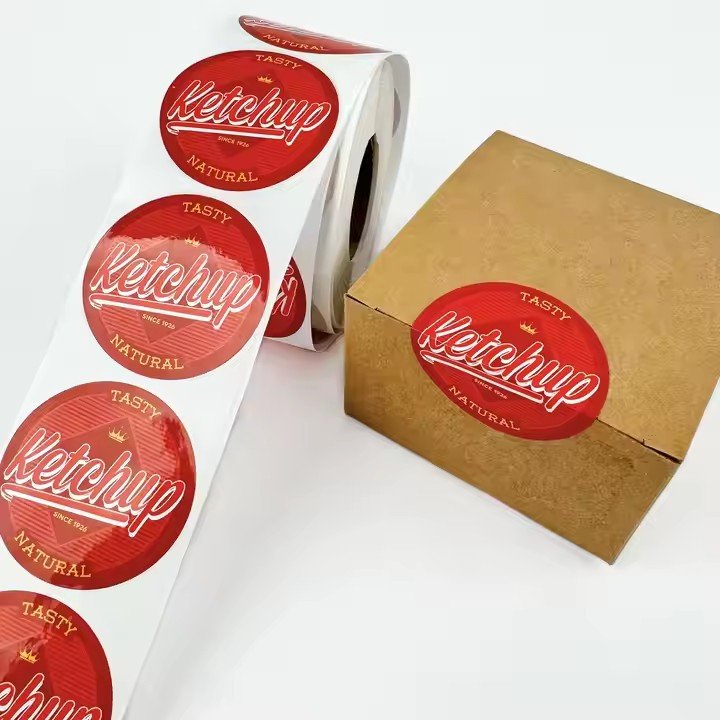I. Retail and FMCG Industry: The Core Choice for Temporary Labeling and Promotions
The retail and fast-moving consumer goods (FMCG) sector is one of the largest application areas for static cling stickers. These stickers are mainly used for short-term promotions, price labeling, and product information display—ideal for frequent changes without damaging packaging.
Promotional Labels
Application Scenarios: Supermarkets and convenience stores for discounted products, “buy-one-get-one” offers, or festive displays (e.g., Chinese New Year, Double 11 shopping festival).
Core Requirements: Promotional periods are short (usually 1–2 weeks); stickers must be quick to apply and remove, and leave no adhesive residue on packaging such as food boxes, beverage bottles, or cosmetic containers to prevent resale issues.
Typical Examples:
Fresh food discount stickers on transparent packaging that can be replaced daily without cleaning.
“New Arrival” labels at cosmetic counters attached to glass displays or product racks, removable after the campaign without damaging fixtures.
Price Tags and Product Information Labels

Application Scenarios: Products with delicate surfaces—such as baby care items, premium gifts, and electronics—where pricing, ingredients, or usage details must be shown.
Core Requirements: Traditional pressure-sensitive labels often leave glue residue, while static cling stickers can be reused and do not damage printed packaging.
Typical Examples:
Infant formula cans with removable “nutritional information” stickers.
Wine bottles with transparent “origin” stickers that do not obstruct design elements and can be easily peeled off.
II. Automotive Industry: A Safe Solution for Temporary Decoration and Information Display
Because vehicle surfaces require non-destructive materials, static cling stickers are widely used in the automotive sector for temporary signage, inspection labels, and informational markings that do not harm paint or glass.
Temporary Windshield Labels
Application Scenarios: Annual inspection stickers, insurance marks, environmental badges (still used in some regions), and temporary parking contact cards.
Core Requirements: Traditional paper labels use adhesives that leave residue and may scratch glass films when removed; static cling stickers attach directly to glass and can be peeled off easily without damage.
Typical Examples:
Annual inspection cling stickers placed inside the windshield—easy to replace during the next inspection without cleaning the glass.
Vehicle Decoration and Safety Notices
Application Scenarios: “New Driver” signs, wedding car decorations, or temporary courtesy reminders during parking.
Core Requirements: Car paint is highly glossy and sensitive to adhesive corrosion; static cling relies purely on electrostatic adsorption, preventing chemical reactions or marks.
Typical Examples:
“New Driver” cling sticker on the rear of a vehicle, removed after the probation period with no paint damage.
Wedding car decorative clings that can be applied and removed quickly without affecting appearance.
III. Home and Interior Design Industry: A Temporary Protection and Labeling Tool
In the home improvement and interior design sectors, static cling stickers are mainly used for surface protection during renovation and temporary labeling after move-in, meeting short-term, no-residue application needs.
Surface Protection During Renovation
Application Scenarios: Newly installed glass doors, cabinet panels, and tiles that need protection from paint splatter, dust, or debris during construction.
Core Requirements: Protection periods usually last 1–3 months; films must cover large surfaces without damaging coatings such as tempered glass, painted panels, or glossy finishes upon removal.
Typical Examples:
Glass protection films up to 1–2 meters wide used on windows to prevent paint splashes, easily removed post-renovation with a clean surface.
Cabinet door clings that protect lacquered panels from scratches and dust during installation without dulling the finish.
Temporary Home Labeling
Application Scenarios: Functional labeling during move-in (e.g., “Wardrobe – Clothing Section”), kitchen spice labeling, or children’s room wall decorations.

Core Requirements: Labels must be adjustable with lifestyle changes, and wall or furniture decorations should leave no residue or surface damage.
Typical Examples:
Kitchen spice bottle clings labeled “Salt,” “Sugar,” or “Soy Sauce,” which can be reused when contents are replaced.
Children’s cartoon wall clings that can be removed as the child grows, leaving the wall unmarked.
IV. Advertising and Exhibition Industry: Efficient Medium for Short-Term Display and Quick Setup
In the advertising and exhibition sector, static cling stickers are ideal for short-term setups and temporary visual displays, fitting the need for fast installation and residue-free removal in rented venues.
Exhibition and Event Decoration
Application Scenarios: Trade show booth glass partitions, wall display graphics, product display pricing, and shopping mall event decorations (e.g., seasonal promotions, brand showcases).


